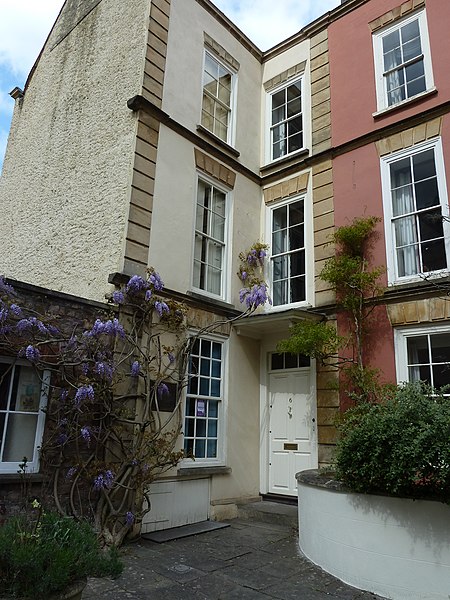This month (June 2011) featured the discovery of nitrous oxide, aka laughing gas, in No Laughing Matter, by John Mann, emeritus professor of chemistry, Queen’s University Belfast. The caption declares:
Had it not been for nitrous oxide’s subversion as a recreational folly, its utility as an anaesthetic could have been uncovered much earlier.The stage was set for its discovery by the work of Thomas Beddoes(1760 – 1808), born in Shropshire, studied medicine and chemistry at Edinburgh, the “Athens of the North”, followed by a medical doctorate at Oxford.

He was appointed reader in chemistry at Oxford in 1788, and his lectures attracted large and appreciative audiences. According to John Mann:
he became disillusioned by the religious fervour and restrictions on study ... and resigned in 1792but Wikipedia, fons scientiae omnis, declares:
his sympathy with the French Revolution exciting a clamour against him, he resigned his readership in 1792.Whereupon he moved to Bristol, and started a clinic in Hotwells, Bristol. This was an era when bad airs were thought to be responsible for many diseases (this is the origin of the name malaria), and since it was widely held that butchers were much less susceptible to tuberculosis, he treated patients by locating them next to a byre full of cattle. It was only about twenty years since oxygen had been more or less simultaneously discovered by Joseph Priestley,Antoine Lavoisier and Carl Wilhelm Scheele, and Beddoes believed this gas to be of great potential in the treatment of many illnesses.
In 1799, he founded the Pneumatic Institution in the same area of Bristol, attracting the attention of renowned by impoverished poets Samuel Taylor Coleridge and Robert Southey.

This attracted the attention of rich benefactors, which allowed him to commission a gas generator from James Watt.
C:\Documents and Settings\Robert\My Documents\Science\Watt_apparatus_3a.JPG
In 1798 he appointed the young Cornishman Humphry Davy as his laboratory superintendent.
Davy embarked upon new research involving ‘dephlogistated nitrous air’, a mixture of nitric oxide (NO)and nitrous oxide (N2O) which Priestley had made by the action of nitric acid on iron filings. He quickly found a way of separating the nitrous oxide from the noxious nitric oxide (though in very small quantities, NO is an essential signalling molecule in the human body.) He then developed the method of preparing it by controlled heating of ammonium nitrate (the main ingredient of a ‘fertilizer bomb’.)

Davy quickly noticed the euphoric effect of N2O on himself and visitors to the Pneumatic Institution, coining the term “laughing gas”. He also accidentally cut himself badly during one of his self-administration sessions, and wrote:
As nitrous oxide in its extensive operation appears capable of destroying physical pain, it may probably be used with advantage during surgical operations in which no great effusion of blood takes place.With visitors such as the two prominent poets above, its use as what we would now call a recreational drug widely caught on, and its potential as an anaesthetic slipped under the radar, especially since in 1801 Davy was head-hunted for the Royal Institution, where many other wonders of science were to occupy his active mind.
Re-discovery of its anaesthetic properties had to wait until 1844, in Hartford, Connecticut. An ex-medical student turned travelling showman named Gardner Quincy Colton was demonstrating the hilarious properties of the gas, when a local dentist by the name of Horace Wells realized its potential in dentistry. For Wells, though, this was not a happy discovery. As Molecule of the Month (from Bristol!) states:
In January 1845, Dr. Wells demonstrated his discovery of the effects of nitrous oxide at the Harvard Medical School in Boston. A patient was anesthetised and a tooth was extracted, but during the demonstration the patient complained that he felt some discomfort. Even though the experiment had been successful (in that the patient had only felt slight discomfort and not excruciating pain), the suspicious audience were unhappy, and booed Wells from the stage. This public humiliation eventually led to Dr. Wells losing his reputation as a professional dentist, and finally to his suicide three years later. Ironically, 150 years after his premature death, his discovery would be adopted by dental practices worldwide, and Wells would be given the accolade - the “Discoverer of Anesthesia”.(The story is even more dramatic than suggested here, and can be read in the linked Wikipedia biography.)
Fortunately for patients, Gardner Colton picked up the trailing threads, and dental anaesthesia became widespead.
So, is there a moral to be had here, about recreational use of drugs eclipsing their medical benefits? I won’t pronounce on this matter, because in my view “God never plays the same gramophone record twice.”
However, some prominent figures among our British entertainmentariat are calling for some drugs to be de-criminalized. I would suggest that, in matters such as this, input from scientists, doctors and lawyers is welcome, but, please,



Comments